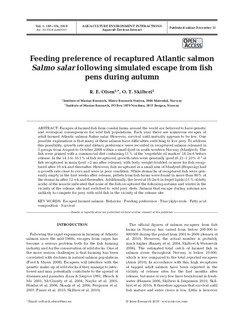Feeding preference of recaptured Atlantic salmon Salmo salar following simulated escape from fish pens during autumn
Journal article, Peer reviewed
Permanent lenke
http://hdl.handle.net/11250/117160Utgivelsesdato
2010-12-21Metadata
Vis full innførselSamlinger
Originalversjon
http://dx.doi.org/10.3354/aei00015Sammendrag
Escapes of farmed fish from coastal farms around the world are believed to have genetic and ecological consequences for wild fish populations. Each year there are numerous escapes of adult farmed Atlantic salmon Salmo salar. However, survival until maturity appears to be low. One possible explanation is that many of these salmon have difficulties switching to live prey. To address this possibility, growth rate and dietary preference were recorded in recaptured salmon released in 3 groups from August to October 2008 within a small fjord in south-western Norway (Masfjord). The fish were primed with a commercial diet containing 11% of the ‘vegetable oil marker’ 18:2n-6 before release. In the 14.5 to 35.1% of fish recaptured, growth rates were generally good (0.21–1.23% d–1 of fish recaptured in main fjord >2 mo after release), with body weight doubled or more for fish recaptured after 19 wk and thereafter. However, fish recaptured in a small arm of Masfjord (Hopsvåg) had a growth rate close to zero and were in poor condition. While stomachs of recaptured fish were generally empty in the first weeks after release, pellets from fish farms were found in more than 80% of the stomachs after 12 wk and thereafter. Additionally, the level of 18:2n-6 in depot lipids (11% of fatty acids) of the muscle indicated that none of the fish recaptured the following autumn and winter in the vicinity of the release site had switched to wild prey diets. Salmon that escape during autumn are unlikely to compete for prey with wild fish in the vicinity of the release site.
